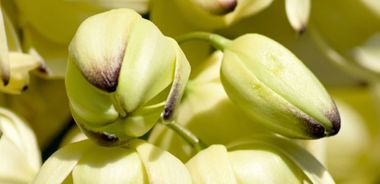Hot Yucca Salad

Both the flowers and the fruit of the yucca are edible. Only eat the flower petals, however, as the flower centres are extremely bitter.
2 bunches arugula, cleaned and dried
4 Tbsp (60 mL) extra-virgin olive oil
1/2 cup (125 mL) pecans
20 to 30 yucca flowers, bitter centres removed
1 Tbsp (15 mL) red wine vinegar
Arrange arugula leaves on plates. Heat olive oil in a small skillet. Add pecans and cook quickly over medium-high heat, stirring frequently. As pecans begin to darken, toss in yucca flowers. Keep them moving in the pan, cooking for no more than 2 minutes. Spoon the pecans and yucca over the arugula. Add the vinegar to the hot pan to deglaze any browned bits of food that may have stuck to the pan. Spoon vinegar over salad. Serve immediately.
Serves 4.
Source: Edible Flowers: From Garden to Palate, by Cathy Wilkinson Barash (Fulcrum, 1993)
source: "Yucca", alive #304, February 2008




